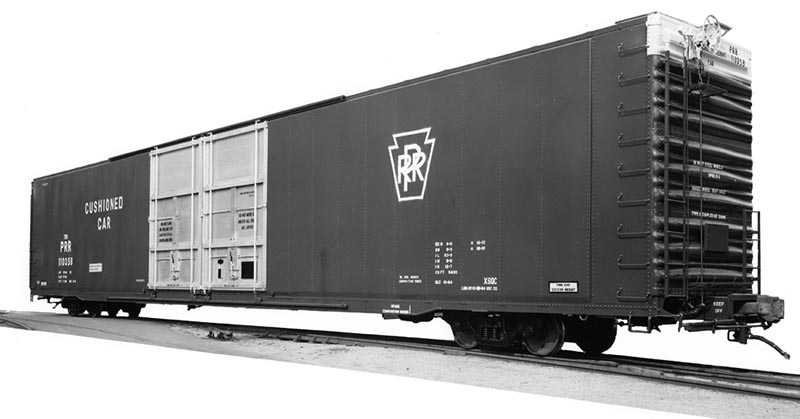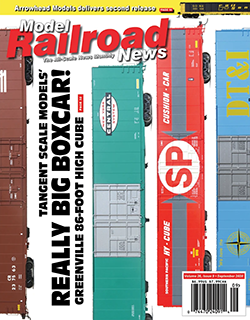What Union Pacific’s mighty double diesels, such as 1969’s “Centennial” DDA40X, were to locomotives of the time, the tall and long high-cube boxcars were to freight cars. These giant boxcars featured a length nearly as long as postwar streamlined passenger cars and stood taller than everything else in regular freight service when they were new.
To better serve the needs of the automobile industry, railroads and freight car builders began in the 1950s experimenting with specialized designs. Moving finished vehicles in boxcars gave way to autoracks in the early 1960s. At the same time, transporting materials involved in producing vehicles received attention. The result was a very long boxcar featuring an excess-height profile.
This new “high cube” design was possible, as automobile components were bulky but didn’t possess over-whelming weight characteristics. Large, tall door openings and an interior that gave equally ample head room from one end of the massive cargo space to the other provided an optimal location for economically moving parts from a factory of origin to an automobile assembly location.

American Car & Foundry built the prototype 86-foot high-cube boxcar in 1963. The project was done in collaboration with Louisville & Nashville, Southern Pacific, and Wabash, with an aim to en-hance hauling auto parts for Ford Motor Company. I came across this neat looking reproduction of this one-of-a-kind boxcar at 2019’s St. Louis RPM. Unfortunately, I didn’t find a nearby card with infor-mation on the model or the hobbyist who built it. The model appears to be an Athearn “blue box” shell with enhancements.
Who’s On First?
The development of 86-foot high-cube boxcars was a joint venture between several U.S. railroads and freight car builder American Car & Foundry (ACF). ACF built a high-cube boxcar of four-door design in 1963 and this forerunner set the style for production that would follow for more than a decade. ACF’s “Ford Stampings Car,” which carried heralds for Louisville & Nashville, Southern Pacific, and Wabash, ended up being an oddity. ACF did not stay in the high cube business, but this design did.
Three-Way Race
Regular production for 86-foot high-cube boxcars went into high gear during 1964. Though ACF didn’t participate, you’ll recognize the names of the other freight car builders: Greenville Steel Car Company, Pullman-Standard, and Thrall Car Manufacturing. In addition to these three freight car manufacturers, a small number of high cubes went to Santa Fe and Southern Pacific built by Pacific Car & Foundry.

ABOVE: Another Greenville builder’s photo shows a ready-to-enter-service Frisco high cube. Note the recessed panel where the grab irons reside on the ends of the car side is more narrow. James Kinkaid designates this a Type II production example. — Greenville photo, James Kinkaid collection
As I began studying these boxcars, I was surprised to learn some interesting facts that I wasn’t aware of before my research began for this article. First, I thought production ceased for 86-foot high-cube boxcars around 1970. This is not the case. Greenville remained in the business of building these long cars through 1978, and was the solo builder of 86-foot high cubes after 1974.
Second, given the models produced over the years I was under the impression that Pullman-Standard built most of these high cubes. This is not correct. Greenville’s output was a bit more than 4,800 examples, which tops second-place builder Thrall’s total by a thousand. And Pullman-Standard was third with approximately 2,500 of these long high-cube boxcars built for North American railroads.

ABOVE: Missouri-Kansas-Texas 8545 is a Type I Greenville prototype. Built in 1969 as part of Katy’s second order, these Greenville high cubes were uncommon with only 14 (MKT 8500–8504 and 8541–8549) on the roster. — Kevin EuDaly collection
Finally, I knew four-door styles were the most common, but I didn’t realize eight-door high cubes were in a such a minority position. I don’t have hard data on this, but my research suggests the four-door style high cube was far and away the most common version.
 Spotter’s Guide
Spotter’s Guide
The cars feature a very modern appearance, but the early examples did follow the traditional boxcar layout with a B-end that included access to the top of the car, rooftop running boards, and high-mounted brake wheel. This layout was nearing its end and the big high cubes were among the first boxcars to shuck running boards and drop tall ladders (the rules changed in 1966 and rolling stock slowly saw modification removing running boards and related equipment or, if not modernized, retirement by the late 1970s).
Regardless of who built these giants, the basic setup was similar with styles including a four-door (two insulated plug doors centered on each side) and an eight-door (two sets of doors per side) version. The all-important spot-ting features that railfans can employ to determine who made a high cube have some general attributes. Though it took me a bit to get the designs properly matched up with car builders, and for many years I thought my dad had some magic power that allowed him to merely glance at a high cube and call out, “That’s a Greenville car.”
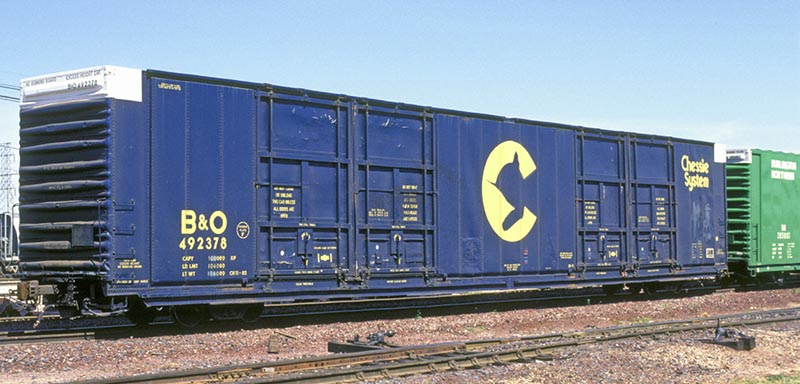
ABOVE: Greenville’s eight-door high cubes were very much in the minority in the freight builder’s production efforts. Baltimore & Ohio 492378 was a 1970-built example and shows a Chessie System repaint in this shot at Fort Worth, Texas, in May 1986. — Dick Kuelbs photo, Kevin EuDaly collection
Here’s how I understand the dif-ferences between the three major builders of high cubes. Greenville’s cars, regardless of production phase, all possess a sill with a fishbelly-type look. The sill starts out at the stirrup step and proceeds straight until just past the trucks, then it dips down slightly and the lower door rails reside along its lower line. On the much less common eight-door Greenville cars, the fishbelly dip begins right after the stirrup steps to catch both sets of lower door rails.
For Pullman-Standard high cubes, you are looking for evidence of vertical side posts. All of these big high cubes include rows of vertical skeletal bars that make up the sides. On Pullman-Standard’s cars (both four-door and eight-door varieties), you can see the lower tips of those vertical bars showing along the sides. This feature is unique to Pullman-Standard-made 86-foot high cubes and makes for the most obvious spotting feature.

ABOVE: Western Pacific 86020 was one of 35 Greenville high cubes the railroad acquired in 1964 at the start of production for these giant 86-foot boxcars. The car was about a year into its service career when captured on film in a Santa Fe train passing through San Bernardino, Calif., in September 1965. — Dick Kuelbs photo, Kevin EuDaly collection
Thrall’s design shares the straight sill present on Pullman-Standard cars, but the car builder concealed those vertical posts behind steel side panels. So, Thrall’s sides look something like Greenville’s with no exterior post detail showing across the lower edge of the car sides, but then they have in common with Pullman-Standard a long straight sill lacking any fishbelly curves along the lower edge.
This is a very simple guide for spotting these cars, but it will benefit you when paging through prototype railroad books or seeing a survivor out in the wild on a freight train.
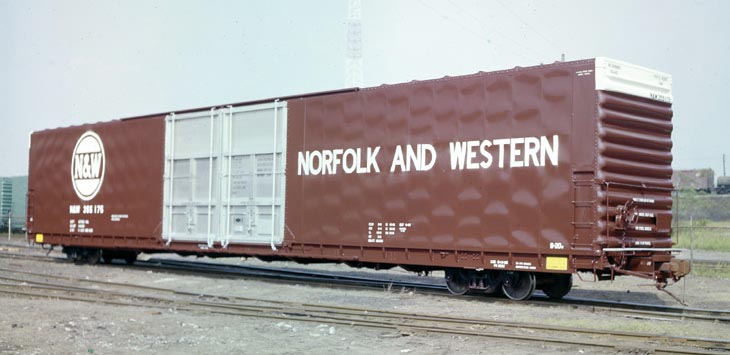
Norfolk & Western 355175 (ABOVE) and Pennsylvania Railroad 110125 (BELOW) show four-door and eight-door examples of Pullman-Standard’s contributions to 86-foot high cubes. These are the prototypes for the two Walthers models featured among past HO examples in this issue’s “From the Archive” on page 90. Though dressed in basic Boxcar Red hues, these two cars show off the large heralds and billboard lettering common to 86-foot high-cube boxcars. — Pullman-Standard photos, James Kinkaid collection
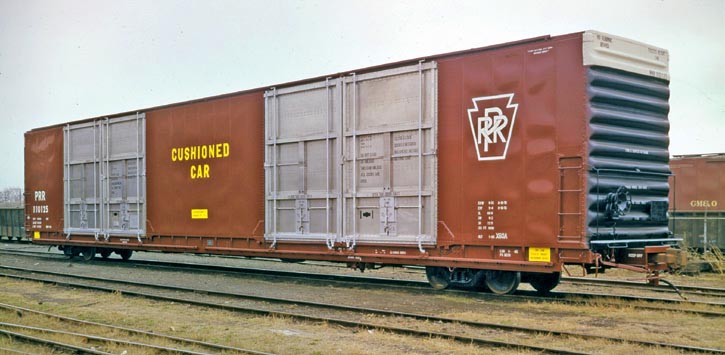
Information can be found in Joseph Peirsen and Ira Kulbersh’s Chicago & North Western Final Car Roster (1999, Chicago & North Western Historical Society). In describing a Thrall-built series of four-door high cubes, the book states the cost was $30,642 in 1964 for this boxcar and it was “designed by a mechanical committee consisting of the mechanical engineers of several railroads.” Participating roads all took nearly identical cars (with interior loading equipment and exterior decoration being the optional features). These cars worked in pool service with multiple road names of a similar type high cube running a circuit between stamping plants producing vehicle components such as hoods and fenders, to assembly plants where those items were put together to turn out new Lincolns, Cadillacs, and other cars.
This hardcover book is also a source for what I frequently have heard over the years regarding the use of the two styles of high cubes. Ford plants used four-door high cubes, while General Motors facilities used eight-door examples. I can’t confirm if this is a hard rule or general practice. I also don’t have information regarding any door preference for Chrysler, and for that matter no information on whether these cars served American Motors in Wisconsin.
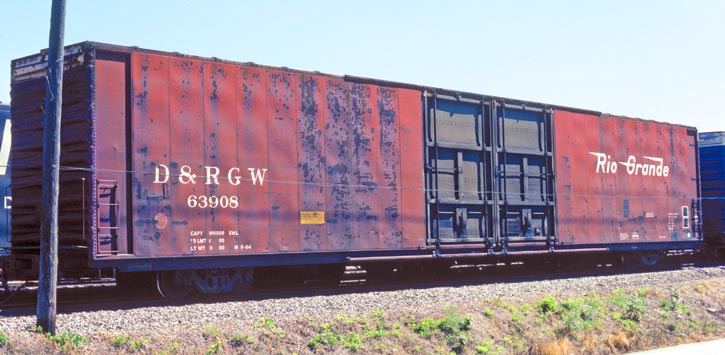
ABOVE: Rio Grande 63908 was an early Thrall-built high cube from 1964. You can see evidence that this car once had running boards on its roof and the location on the B-end (right) side where a tall ladder originally stood. — Dick Kuelbs photo, Kevin EuDaly collection
Not Just Auto Parts
Though they are famous for being auto parts haulers, these boxcars performed, and still perform, many jobs. Products with a low-density weight that present a bulky footprint are ideal for transport in these tall and long boxcars. You’ll find high cubes of this variety could be cereal movers or handle finished appliances (such as refrigerators).
If you look, you’ll find these boxcar giants still working. There’s an auto parts train that I occasionally see, or hear a report my dad caught, that runs on Norfolk Southern between Kansas City, Mo., and at least Decatur, Ill. While those cars are doing the job railfans think of them for, my dad and I also spot them with regular-ity on Kansas City Southern mixed freights operating into St. Louis, Mo. In these consists a couple high cubes will be seen and are thought to be hauling home appliances assembled in Mexico.
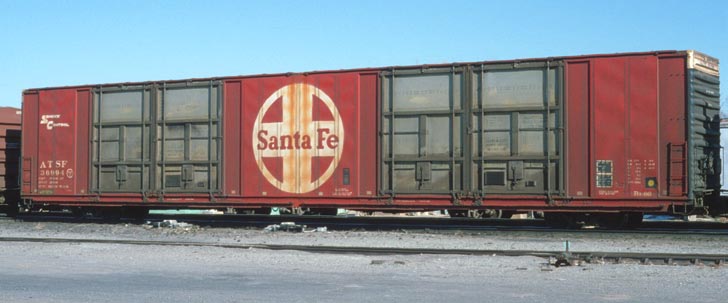
ABOVE: Santa Fe owned 86-foot high cubes from all three major builders (Greenville, Pullman-Standard, and Thrall). ATSF 36994 is an example of Thrall’s early production eight-door prototype and was at Belen, N.M., in early 1979. — Peter Arnold photo, Kevin EuDaly collection
Miniature High Cubes
In this issue’s “From the Archive,” I cover HO-scale 86-foot high-cube boxcar models of the past and thus won’t go into those here. This is an area where N scale has outdone HO for many years.
Introduced not long after the prototypes arrived, Roco made an N-scale eight-door high cube that appears to reproduce a Pullman-Standard design. The model was first marketed in North America by Atlas. Another 1960s plastic N-scale effort came from Arnold/Rapido and presents a four-door Greenville prototype. A similar car with enhancements came from Con-Cor in the 1980s. Con-Cor also marketed an eight-door high cube similar to the one from Roco/Atlas. Another vintage N-scale high cube provides a plastic model of Pa-cific Car & Foundry’s outside-braced eight-door prototype, complete with early production tall ladders, high-mounted brake wheel, and running boards.
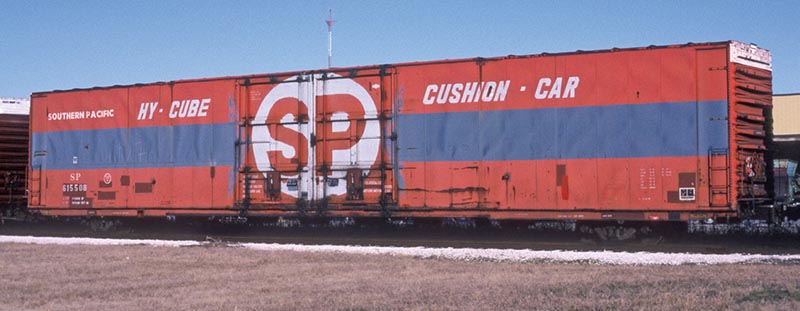
ABOVE: Southern Pacific 615508 was still wearing its as-delivered paint scheme in the mid-1990s when it was photographed at Carrollton, Texas, on February 13, 1994. — Dick Kuelbs photo, Kevin EuDaly collection
For those seeking a more con-temporary tooling attempt, you’ll find excellent models produced by Bluford Shops reproducing Pullman-Standard’s four- and eight-door prototypes.
If you’re wanting a model larger than HO, Lionel offers a scale reproduction in O (1:48) for Pullman-Standard’s four- and eight-door examples. I bought one decorated for Wabash for a mantel display model and I can confirm it’s an amazing effort! If I’ve missed other 86-foot high-cube boxcars in my listing of scales other than HO, please drop me an email.
Though their length can present challenges to operations on some model railroads (tight curves can be unfriendly and the overhang on said curves can cause some clearance con-cerns for signs, telephone poles, and trees), 86-foot high-cube boxcars are a feast for the eyes. In any scale, their ample size makes for an impressive model. The 1960s and into the early 1970s decorations, many of which are on display across these pages, make fantastic-looking boxcars with large railroad heralds and big, bold lettering boasting features possessed by the prototypes.
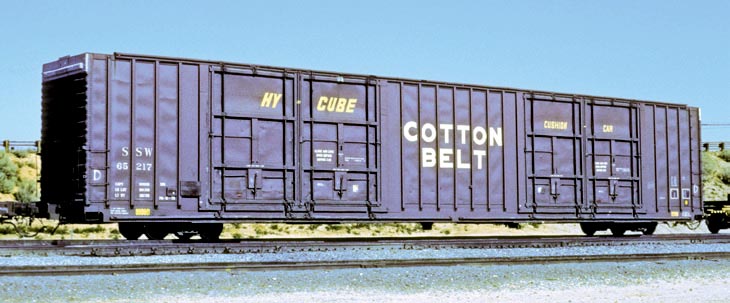
ABOVE: As happened to many of the elaborate paint schemes over time, simplification was the directive in repainting high cubes. This is an uncommon Pacific Car & Foundry (PC&F) outside-braced, eight-door high cube that Southern Pacific, its subsidiary Cotton Belt, and Santa Fe owned. SSW 65217 was baking in the sun on what looks like a hot day in late August 1986 at Mojave, Calif. In addition to PC&F’s minor production role (all its 86-foot high cubes were produced in 1964) and the one-off ACF prototype, Whitehead & Kales built one car for Southern Pacific in 1963. Additionally, Penn Central’s Despatch Shops constructed 154 four-door examples with riveted sides in 1970. — Kevin EuDaly collection
The More You Know…
I don’t know of any single reference book on these 86-foot high-cube boxcars. James Kinkaid covered Greenville and Pullman-Standard efforts about 15 years ago in Mainline Modeler magazine. You will see specific information on what issues to seek out for Greenville cars in the review of Tangent Scale Models’ new HO replica in this edition.
Drawings and information for Pullman-Standard’s high cubes appeared in a three-part Mainline Modeler series (May, June, July 2003). You’ll find Pullman-Standard’s four-door and eight-door high cube included among drawings in the softcover Freight Car Handbook (2018, White River Productions).

ABOVE: Though it still promotes its protective cushion underframe in respectable-size lettering, the pre-sentation of Southern Pacific’s name in the upper right corner gives the impression the local hobby shop only had Z-scale decals in stock when this job came up. The car is an early production Thrall four-door example. — Dick Kuelbs photo, Kevin EuDaly collection
Examples appear in many collections of railroad rolling stock color books. And drawings can be sourced, along with black & white prototype pictures in 1960s era Car & Locomotive Cyclopedia volumes.
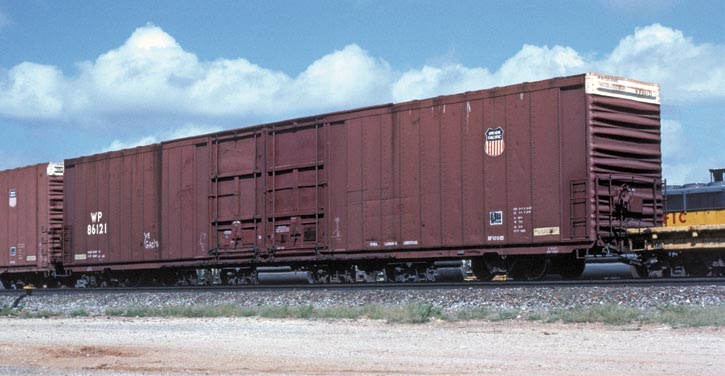
ABOVE: Photographed at Fort Worth, Texas, in June 1996, this Union Pacific repaint shows a Thrall-built four-door high cube with Western Pacific reporting marks. The later era looks for high cubes didn’t take advantage of the massive canvas availble for works of art like earlier liveries employed. — Dick Kuelbs photo, Kevin EuDaly collection


